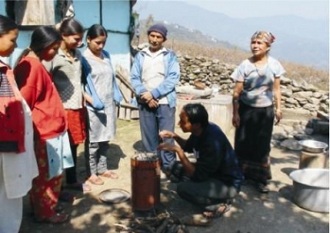DAR ES SALAAM, Jan 2 (IPS) – Tanzania’s electricity grid is fed by a mixture of natural gas, diesel and hydropower; however, over the past few years the country has experienced severe blackouts and power rationing in urban areas due to drought and subsequent low-water levels.
After seeing springs and rivers in his native Kilimanjaro region dry up, Estomih Sawe wanted to provide energy alternatives for Tanzanians.
“Only 10 percent of people in this country have access to electricity. People like us, we are lucky!” said Sawe, sitting in his air-conditioned office in Dar es Salaam, Tanzania’s capital.
“In rural areas, where more than 80 percent of people live, only two percent have access to electricity. So you can imagine the major task we have ahead.”
Tanzania burns one million tonnes of charcoal each year; which amounts to clearing more than 300 hectares of forest every day to produce charcoal.
“Unfortunately the rate of cutting trees and replacing them is not proportionate,” said Sawe. “If you do the math, 300 hectares per day x 365 days equals…” 109,500 hectares per year.
“We are only able to plant 25,000 hectares annually, so it is indeed a very serious problem for our environment.”
Sawe initiated TaTEDO – the Tanzania Traditional Energy and Development and Environment Organisation – in 1999, to put into practice knowledge he gained from working as the head of the renewable energy sector for the country’s energy ministry.
“One of the major problems is really the use of solid biofuels,” said Sawe, “which includes the use of firewood and charcoal, of which the technology and use is very inefficient.”
The stoves most commonly used in Tanzania – three-stone fireplaces for wood and metal stoves that burn charcoal – waste more than 85 percent of the energy potential of their fuel.
“The number of people who are dying, particularly women and children, from inhaling the smoke is increasing,” Sawe adds. “The World Health Organisation says that more than 75 people are dying daily here in Tanzania from inhaling smoke while with these inefficient technologies.”
But making changes is complicated by overlapping factors including gender and poverty, according to the Household Energy Network (HEDON).
The gendered division of labour usually means that women are responsible for most domestic tasks; women and children are worst affected by the health impacts of smoke inhalation for example.
But women’s influence on decision-making in the household is limited by their economic dependency on men. According to the UN-HABITAT, where women are economically empowered, they are more likely to adopt better technologies to change damaging energy practices and improve the living conditions of their families.
In the rural village of Igunhwa in the Mwanza region of northern Tanzania, several women’s groups have been formed to take advantage of micro-finance schemes and construct more efficient mud stoves designed by TaTEDO.
“Before we were introduced to the mud stoves we were using traditional three-stone fire places for cooking,” said Florence Ngembwe* of the Upendo women’s group. “The problems with using the three-stone fireplaces were that we would use a lot of firewood for cooking, and it is only the women and girls who are collecting the wood.
“There was also a lot of impacts on women’s health, due to smoke while cooking inside. We would waste a lot of time fetching wood instead of doing other productive activities, and often girls would be doing this work too, so they weren’t going to school.”
Many of the women involved in the project said that the construction of improved stoves has helped them significantly. They now have a reduced workload, less firewood collection and the new stoves have chimneys, which means much less smoke inside their kitchens.
According to Sawe, more than 80 percent of urban residents use charcoal for cooking. TaTEDO claims that in Dar es Salaam, around 60 percent of households have been helped to switch to improved charcoal stoves which lower both costs and the burden on the environment through greater efficiency.
“It is quite a challenging undertaking,” said Sawe. “Firstly you are dealing with people with limited means, limited incomes. Here we are talking about technologies where the initial costs are high, which means the progress for up-taking the technologies is limited because people are poor.
Some of the other areas in which TaTEDO work include; making alternative fuels for stoves out of the waste material from tree-felling, and from other agricultural residues. “You don’t have to cut a tree to make charcoal,” said Sawe. They have been using rice husks and coconut shells, as well as sawdust to create fuel briquettes.
Through the introduction of the new stoves, TaTEDO claims to save more than 4,500 ha of trees in the areas they work in. But despite dawning realisation of the real effects of climate change – 2009 was the driest year on record – the switch to more sustainable technologies is slow.
“Of course there are cultural problems; if you are dealing with people who have been using three-stone fireplaces for many years it will take quite an effort to change into a new technology even if it a very good one.”
Source – IPS News



